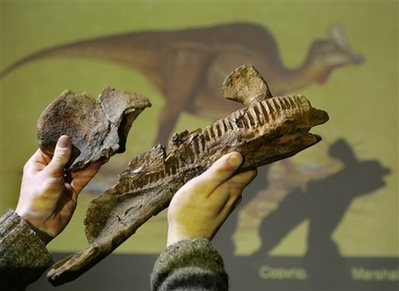New dinosaur species discovered in Mexico
Updated: 2008-02-13 09:07
SALT LAKE CITY - A new dinosaur species was discovered in Mexico, scientists said Tuesday, and experts are hailing the find as a new stage in North American paleontological research.
 Utah paleontologist Terry Gates holds the fossilized bill, left, and jawbone of a new species of a duck-billed dinosaur in front of an artist's rendition of the beast at a news conference Tuesday, February 12, 2008, in the Utah Museum of Natural History at the University of Utah in Salt Lake City. The indentations in the jaw once held teeth. [Agencies]
|
The composition of its skull - with a nose on top of its head and elongated nasal passages - means its call was probably one of its most unique aspects, said Terry Gates, a Utah Museum of Natural History paleontologist who was part of a team of Mexican, American and Canadian experts involved with the excavation.
"They were like little trumpeters," he said. "This is totally odd and freakish."
Scientists have dated the fossil to about 72 million years ago, when much of eastern Mexico was still underwater. They discussed the dinosaur find - which was published in the Journal of Veterbrate Paleontology in December - at a news conference at the University of Utah.
The fossil was discovered 13 years ago in a quarry near Saltillo, the capital city of the Mexican state of Coahuila. Excavators worked to bring it out of the ground and clean it up and 12 years later, after much digging, drilling and piecing together, it became clear that the helmet-crested, duck-billed dinosaur did not belong to any previously identified species. This was new.
The dinosaur was about 25 feet (7.6 meters) long when it died, still in adolescence. Members of the species could likely have grown up to 35 feet (about 11 meters) long, Gates said.
That would have put the species, named Velafrons coahuilensis, around the same size as the Tyrannosaurus rex - though it probably was not as vicious, it being a plant eater.
"Velafrons was probably a beach bum," Gates said.
Its meekness could have contributed to the velafrons relatively short 10-million-year lifespan as a species, said Utah's state paleontologist Jim Kirkland, another expert involved with the project.
|
|||
Researchers said the discovery helps fill in holes in the existing picture of the hadrosaur family, which could include as many as 10 varieties of duck-billed dinosaurs across North America.
"Up in Canada, there is a dinosaur very similar to this," Gates said. He said that could suggest migration patterns over time.
Scott Sampson, research curator at the museum, said the discovery answers existing questions and poses new ones.
"This has opened up a whole new window - but also a whole new mystery - into the world of dinosaurs, and we hope Mexico holds the answers," he said. "The reality is, we've just scratched the surface."
Sampson also said information about another new species from a nearby site - a relative of the triceratops - should be available this fall.
|
|
|
||
|
||
|
|
|
|



